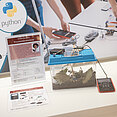Woodlice biotope with the TI-Nspire and BBC micro:bit

This project consists of two parts. In the first part, students research the ideal environmental factors for a woodlice biotope, after which they will also design and build it themselves. The focus in
Publisher: T³ Vlaanderen
Author: Natalie Dirckx, Evelyn Blocken, Ann-Kathrin Coenen
Tags BBC micro:bit , Programming
This project consists of two parts. In the first part, students research the ideal environmental factors for a woodlice biotope, after which they will also design and build it themselves. The focus in this is mainly on finding information from sources, formulating research questions and making graphs. In the second part, they investigate how the environmental factors in the biotope can be monitored with the TI-Nspire and various sensors. Here the main focus is on working with and programming the TI-Nspire. In addition students will have to work out their own experiments and write the lab report, with the method and supplies.
Part 1: In the lab, Professor Marijns is at her wit's end. She is a professor of biology and is looking for woodlice to start her research in January. She wants to investigate whether these animals can help with composting in greenhouse farming. If they can help make the soil more fertile, then greenhouse production could increase. So to do this, the professor needs woodlice and more importantly ...
She needs terrariums in which she can make her woodlice live in the lab. Such a terrarium should be a perfect home for the woodlice. However, the professor's assistants are abroad on another research assignment. She herself has no time to build perfect terrariums. She now asks for your help to research how to build a woodlouse terrarium to give the woodlice an ideal home, where they feel happy and have enough to eat during her research. Prof. Marijns wishes you the best of luck in creating a monitored terrarium!
In this project, students investigate the needs of woodlice through a literature review and experiments. Afterwards, they will use this knowledge to build a woodlice biotope.
Part 2: Do you remember the story of Professor Marijns and her woodlouse research? Last year you helped Professor Marijns' lab very much. Thank you so much for that! Unfortunately, she now encounters a new problem. Through your research we know what the ideal biotope for woodlice looks like, but now she is looking for a way to monitor these different factors. This way it can be indicated that one or more of the environmental factors are no longer at their ideal levels. She asks for your help for this. Professor Marijns wishes you the best of luck in creating a monitored terrarium!
From the previous project, students already know that woodlice prefer to live in dark, cold and humid environments. The students must now test the limits of these environmental factors in order to program the sensors correctly with the TI-Nspire. For this, they themselves think of an experiment to test this. They write out their own method and list of supplies.
Publisher specific license
Documents:
-
 Temperature_sensor.tns
Temperature_sensor.tns
-
 Lesson_3_Woodlice_experiment_procedure.pdf
Lesson_3_Woodlice_experiment_procedure.pdf
-
 Lesson_2_Woodlice_determination_card.pdf
Lesson_2_Woodlice_determination_card.pdf
-
 Workshop_woodlice_biotope_Nspire_student_bundle_part_2.pdf
Workshop_woodlice_biotope_Nspire_student_bundle_part_2.pdf
-
 Workshop_woodlice_biotope_student_bundle_part_1.pdf
Workshop_woodlice_biotope_student_bundle_part_1.pdf
-
 Workshop_woodlice_biotope_Nspire_teachers_bundle_part_2.pdf
Workshop_woodlice_biotope_Nspire_teachers_bundle_part_2.pdf
-
 Biotope.tns
Biotope.tns
-
 Workshop_woodlice_biotope_teachers_bundle_part_1.pdf
Workshop_woodlice_biotope_teachers_bundle_part_1.pdf
-
 Lesson_3_Results_environmental_factors.xlsx
Lesson_3_Results_environmental_factors.xlsx
-
 Light_level_sensor.tns
Light_level_sensor.tns
-
 Soil_moisture_sensor.tns
Soil_moisture_sensor.tns
